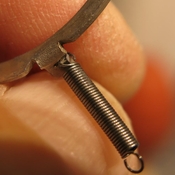SalveSlog
Subscriber
I recently repaired a messed up 531/2 Super Ikonta. I even managed to get the rangefinder working correctly! That was more than I really deared hope for. But I believe the shutter has been tensioned for a long time, because the main spring is probably weaker than when new. This makes the 1/1 run slow at around 1.7 second. (The 1/100 runs fine, which I think tells me that when there is no resistance other than the basic chain from the spring to the blades, the spring is just strong enough to drive it.)
Attached picture shows the (same) spring from another similar camera/shutter that runs fine on all speeds. I could perhaps try moving that over to the Super Ikonta. But is it possible to shorten the original spring slightly to make it stronger? Is there a big risk of breaking it?
Attached picture shows the (same) spring from another similar camera/shutter that runs fine on all speeds. I could perhaps try moving that over to the Super Ikonta. But is it possible to shorten the original spring slightly to make it stronger? Is there a big risk of breaking it?




